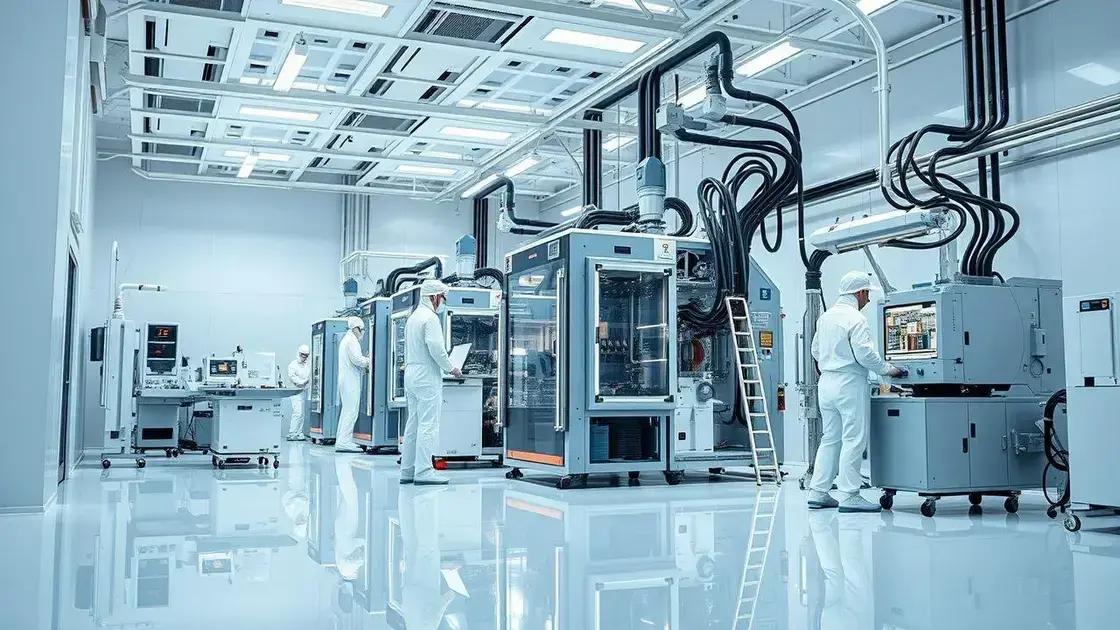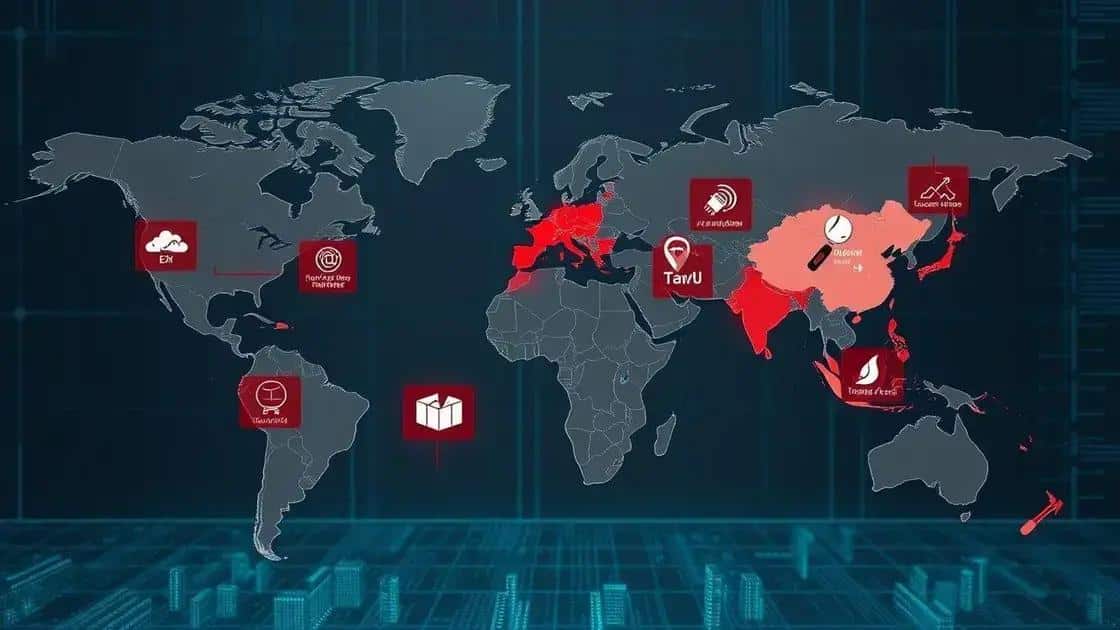Semiconductor supply news trends: what you need to know

Semiconductor supply news trends highlight the challenges from global disruptions, key industry players, and the increasing demand driven by technologies like AI and 5G, which are reshaping production and market dynamics.
Semiconductor supply news trends are making headlines as they influence various sectors from technology to automotive. Have you ever wondered how these trends affect your everyday life? Let’s dive in and explore the latest insights.
Current challenges in semiconductor supply chains
The current challenges in semiconductor supply chains are complex and vary across the globe. As industries increasingly depend on these vital components, issues like delays and shortages can have far-reaching effects.
Understanding Supply Chain Disruptions
Several key factors contribute to disruptions in the semiconductor supply chain. For instance, natural disasters can halt production, while geopolitical tensions may affect sourcing materials. The impact of the COVID-19 pandemic has also had a significant role in altering production schedules.
- Natural disasters affecting manufacturing plants
- Geopolitical tensions hindering material sourcing
- COVID-19’s impact on operational capabilities
- Increased demand outpacing production capacity
In addition to external factors, there are internal challenges that semiconductor manufacturers face. A shortage of skilled workers can lead to slower production times. Furthermore, companies often struggle with managing inventory effectively.
Market Variability
The semiconductor market can change rapidly, making it difficult for manufacturers to keep up. Companies may find themselves either overproducing or underproducing based on inaccurate demand forecasts. This unpredictability complicates planning and logistics.
Innovation also plays a crucial role in addressing these challenges. As technology evolves, companies are adopting new methods to enhance efficiency and resilience. Implementing advanced manufacturing techniques can improve output while reducing waste.
As industries adapt to these changing conditions, it is clear that understanding the current challenges in semiconductor supply chains is essential for staying competitive. By addressing both external and internal factors, businesses can better navigate the complexities of this vital industry.
Impact of global events on semiconductor availability

The impact of global events on semiconductor availability cannot be understated. As various events unfold worldwide, they significantly shape the production and distribution of semiconductors.
Economic Fluctuations
When the global economy experiences fluctuations, demand for semiconductors often follows suit. Economic growth typically drives the need for electronics, leading to higher semiconductor consumption. Conversely, downturns can result in reduced orders, creating an unstable market.
- Growing demand during economic booms
- Decreased orders in economic downturns
- Investment in technology amidst recovery
- Inflation affecting production costs
Additionally, trade disputes and tariffs can create hurdles for semiconductor manufacturers and distributors. These restrictions can lead to increased costs and supply chain delays, further affecting availability.
Natural Disasters
Natural disasters also play a significant role in semiconductor availability. Events such as hurricanes, earthquakes, or floods can disrupt manufacturing facilities, halting production entirely. This leads to a ripple effect where shortages in certain regions can affect global supply.
Moreover, logistical challenges due to global events can complicate transportation of raw materials and finished products. Manufacturers often find it difficult to source components, resulting in prolonged lead times. This unpredictability poses challenges, especially for industries relying heavily on timely semiconductor supply.
Furthermore, the recent pandemic has highlighted how global events can drastically shift the supply landscape. Supply chain disruptions due to workforce shortages and restrictions have made it challenging to meet the rising demand for chips in various sectors.
Key players driving the semiconductor market
The key players driving the semiconductor market are influential figures and companies that shape industry trends. Understanding these players helps us grasp how the market evolves.
Major Corporations
Large technology companies dominate the semiconductor landscape. They invest heavily in research and development to create advanced chips that power everything from smartphones to computers. Some of these leading corporations include:
- Intel: Known for its wide range of processors.
- Samsung: A top manufacturer of memory chips.
- Taiwan Semiconductor Manufacturing Company (TSMC): Focuses on semiconductor fabrication and is a vital supplier for many tech firms.
- NVIDIA: Renowned for graphics processing units (GPUs) and AI technology.
These companies not only drive innovation but also compete fiercely for market share. Their business decisions can significantly influence pricing and availability of semiconductors.
Emerging Companies
In addition to established giants, new players are entering the semiconductor market. These companies often focus on niche products or cutting-edge technologies. Startups can disrupt the industry by offering imaginative solutions that challenge traditional designs. As a result, they can contribute to the evolution of chip technology.
Furthermore, partnerships and collaborations between these key players can lead to significant advancements. Collaborations can promote shared knowledge and resources, ultimately benefiting end consumers with better products.
As we explore the key players driving the semiconductor market, it is essential to recognize their impact on technology and economic growth. Their decisions shape not only product availability but also influence future trends in the industry.
Future trends in semiconductor production and demand

The future trends in semiconductor production and demand are pivotal as industries adapt to new technologies. As the world becomes more digital, the need for semiconductors is expected to rise significantly.
Technological Innovations
One major trend is the ongoing technological innovation in semiconductor manufacturing. Companies are developing smaller, more efficient chips that consume less power and offer greater performance. This trend will likely continue as the demand for energy-efficient electronics grows.
- Advancements in 5G technology.
- Increased use of artificial intelligence in chips.
- Growth of wearable technology.
- Emergence of quantum computing.
As these technologies evolve, semiconductor manufacturers will have to rethink their production methods. Embracing automation and advanced materials will enhance efficiency and reduce costs.
Market Demand Shifts
Additionally, shifts in market demand are shaping the semiconductor landscape. With the rise of electric vehicles and smart home devices, diverse industries will need more semiconductors. Companies in these markets will increasingly rely on semiconductor supply to meet consumer expectations.
The COVID-19 pandemic has further accelerated this trend, as more people turn to digital solutions for work and communication. The surge in remote working solutions has created a permanent change in demand for specific electronic products, leading to a restructuring in semiconductor supply chains.
As industries plan for the future trends in semiconductor production and demand, adaptability and forward-thinking will be essential. By anticipating shifts and investing in new technologies, manufacturers can better meet the growing needs of the market.
In conclusion, the semiconductor industry is rapidly evolving, driven by innovations and shifting market demands. Understanding the current challenges and the key players involved can help businesses navigate this complex landscape. As technology continues to advance, the future trends in semiconductor production and demand will likely focus on efficiency and adaptiveness. Embracing these changes will be crucial for manufacturers and industries dependent on semiconductors. By staying informed and proactive, we can better anticipate future needs and opportunities in this vital sector.
FAQ – Frequently Asked Questions about Semiconductor Supply Trends
What are the main challenges in the semiconductor supply chain?
The main challenges include disruptions from global events, natural disasters, and inconsistencies in production schedules.
Who are the key players in the semiconductor market?
Major players include Intel, Samsung, Taiwan Semiconductor Manufacturing Company (TSMC), and NVIDIA, who lead in innovations and market share.
What future trends should we expect in semiconductor production?
Future trends will likely focus on increased demand for AI technologies, IoT devices, and advancements in 5G communications.
How important is efficiency in semiconductor manufacturing?
Efficiency is crucial as manufacturers strive to produce energy-efficient solutions to meet growing global demands and reduce costs.





